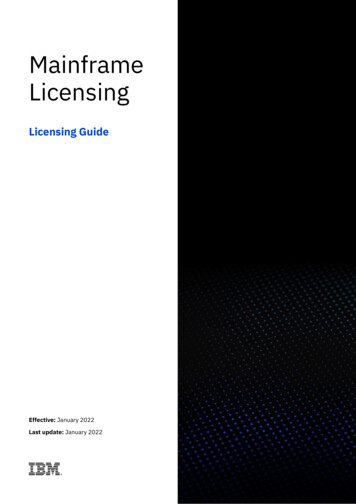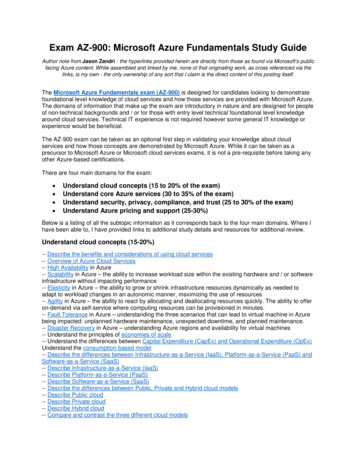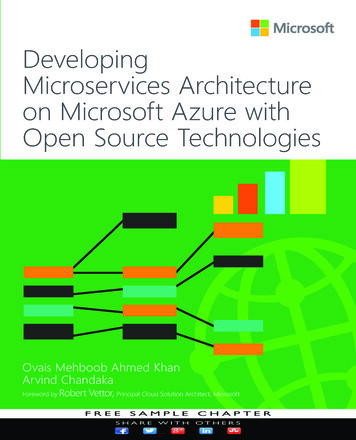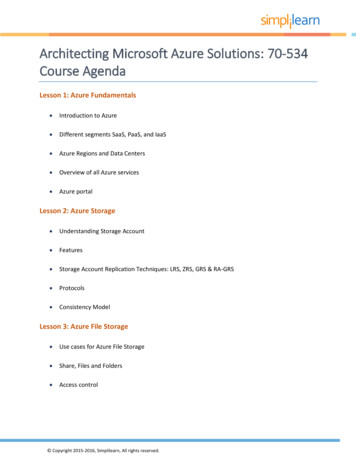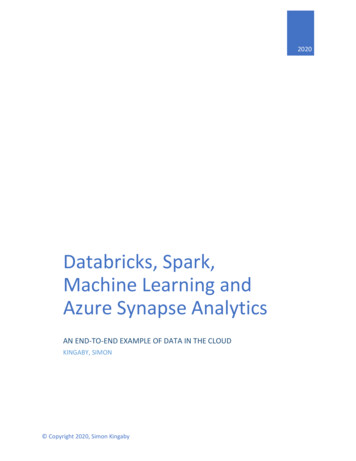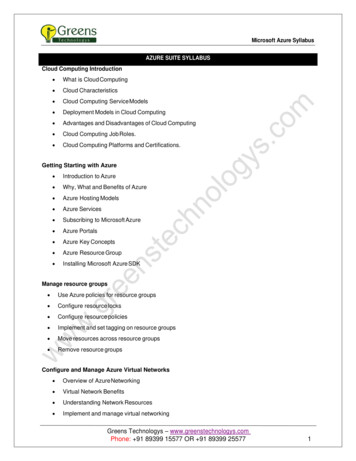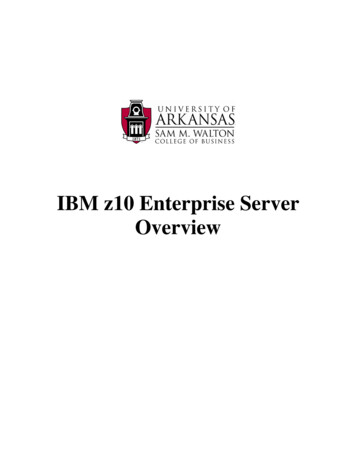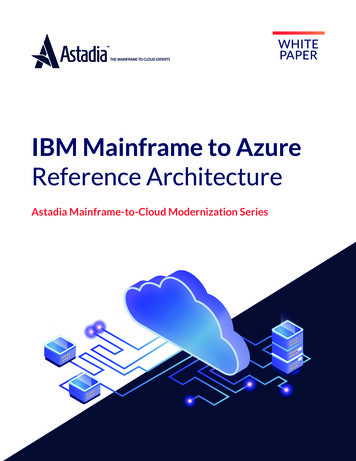
Transcription
WHITEPAPERIBM Mainframe to AzureReference ArchitectureAstadia Mainframe-to-Cloud Modernization Series
AbstractIn businesses today, across all market segments, cloud computinghas become the focus of current and future technology needsfor the enterprise. The cloud offers compelling economics, thelatest technologies and platforms and the agility to adapt yourIn this document, we will explore:information systems quickly and efficiently. However, many Why modernize a mainframelarge organizations are burdened by much older, previous The challenges associated with mainframegeneration platforms, typically in the form of a mainframecomputing environment.Although old and very expensive to maintain, the mainframeplatform continues to run the most important informationsystems of an organization. The purpose of this referencemodernization An overview of the IBM mainframe The IBM Mainframe to Azure ReferenceArchitecturearchitecture is to assist business and IT professionals as they An overview of Azure servicesprepare plans and project teams to start the process of moving A look at the Astadia Success Methodologymainframe-based application portfolios to Microsoft Azure.We will also share various techniques and methodologiesthat may be used in forming a complete and effective LegacyModernization plan.This document is part of the Astadia Mainframe-to-Cloud Modernization Series that leveragesAstadia’s 25 years of mainframe platform modernization expertise.2IBM MAINFRAME TO AZURE REFERENCE ARCHITECTURE
Table of ContentsIntroduction. 4Why Should We Migrate Our Mainframe Apps to Microsoft Azure?. 5Benefits of Mainframe Modernization. 5Approaches to Mainframe Modernization. 5Challenges of Mainframe Modernization . 6Why Azure?. 7Achieving the Positive Impact of Change. 7Understanding Typical IBM Mainframe Architecture. 8IBM Mainframe Heritage. 8IBM Mainframe Components. 9IBM Mainframe to Azure Reference Architecture. 10Understanding Microsoft Azure. 14Ensuring Project Success.17Astadia Mainframe-to-Azure Success Methodology. 17Conclusion. 193IBM MAINFRAME TO AZURE REFERENCE ARCHITECTURE
IntroductionThe Microsoft Azure cloud computing platform is an excellent targettechnology platform and business user profile currently in use. Onceenvironment for transitioning from a mainframe workload to a cloudcompleted, the results of this application rationalization will thenimplementation. With the security features of Azure and the abilityguide the sequence of application migration, as well as the differentto scale based on demand for the services, Azure offers a completemodernization strategies and techniques that may be called uponoperational environment in support of mainframe workloads that haveover the course of the entire project. We’ve included an overview ofbeen migrated to the cloud. In addition, Azure supports innovationhow Astadia tackles Legacy Modernization projects with our Successof the application portfolio, previously held captive by the inflexibleMethodology to give you an idea of what’s involved.nature of a mainframe computing model, improving the productivityof application developers and support personnel.Don’t let the enormity and importance of a mainframe modernizationproject deter you from getting started. The skilled individuals neededEven more than a typical IT project, planning to modernize mainframeto continue to maintain mainframes are increasingly leaving theapplications is the most important phase of the total project effort.workforce through retirement and are not being replaced. HardwareA good place to begin is with a thorough assessment of the existingand software maintenance costs continue to escalate and theoverall mainframe application portfolio. Through the assessmentdemands of customers, employees and partners require greaterprocess, all aspects of the existing portfolio will be inventoried andinnovation than mainframe platforms can support.examined in detail, resulting in a catalog of each application, database,How to UseThis ReferenceArchitectureBegin by reading the “Why Should I Migrate” sectionfirst. From there: Mainframe Experts: Skip to the IBM Mainframe to AzureReference Architecture and the Understanding Azure sections Azure Experts: Start with the Understanding IBM Mainframessection, followed by the Reference Architecture. Business Leaders: Spend time with the “Why Should I Migrate ”section and the Ensuring Project Success section at the end.About AstadiaAstadia is a Microsoft Gold Partner that has been in the legacy modernization business since 1994 andhas successfully completed more than 200 mainframe modernization projects.Our repeated success has allowed us to develop a comprehensive methodology, proprietary softwaretools and techniques, as well as the “know how” that comes with more than 25 years of experiencehandling mission critical applications and data.We’re pleased to share some of that experience with you through our Mainframe to CloudModernization Series of reference architectures, webinars, whitepapers and more.Visit our website at www.astadia.com for additional information.Visit our website at www.astadia.com for additional information.4IBM MAINFRAME TO AZURE REFERENCE ARCHITECTURE
Why Should We Migrate Our Mainframe Apps to Azure?Over the past 10 years, public cloud computing has emerged as the foundation of future enterprisetechnology. In terms of technology generations, mainframes are at least two generations old, perhapsthree. Yet, they still survive today and are responsible for running key financial, healthcare and other vitaland sensitive systems around the world.So, why should you migrate your mainframe workloads, why migrate them to Azure and why isnow the right time?Benefits of Mainframe ModernizationReuse – Often called “lift and shift,” this is a process that reuses theThe specific benefits in moving any mainframe workload will varyexisting code/program/applications, typically written in COBOL, bybetween organizations and even at the application and databaselevel. In general, here are three of the top reasons driving legacymodernization projects today:Cost – The economics of cloud computing are compelling whencompared with the status quo of maintaining a mainframeenvironment. A total cost of ownership (TCO) evaluation of themoving them off the mainframe and recompiling the code to runin a mainframe emulator hosted in a cloud instance. This approachminimizes the upfront risks and the length of the project, realizinghardware and software cost savings soonest.Running mainframe applications in an Azure-hosted emulator alsoopens the possibility of innovation leveraging APIs to previouslysubscription-based, consumption-driven cost model of the cloudinaccessible programs and data.versus the exorbitant hardware and software maintenance costs ofRewrite – It may be tempting to say, “Let’s just write new programsmainframes will show a very appealing and short-term achievablefrom scratch,” to modernize the mainframe applications. ThisROI (potentially less than 12 months from project completion).approach is extremely risky and fails a vast majority of the time. It isPeople – Mainframe-specific technical skills are not being replacedcomplex, costly and time consuming. The resources and investmentby today’s college or technology trade school graduates. The pool ofrequired tends to greatly exceed the forecast.available talent with relevant knowledge and experience is shrinkingA new, modern codebase may still be the correct end objective,exponentially each year. The cloud leverages modern technologybut a better approach would be to first move the applications toand its use is ingrained into young software engineers worldwide.a cloud-based emulator, migrate the database to a cloud-basedFlexibility – The cloud offers an Open Systems environmentdatabase, then focus on replacing modules/code over a deliberate,in which high productivity and rapid innovation happen at atremendous rate. A properly designed implementation of amulti-phased approach. When it is time to rewrite, there are severalcode transformation engines you can choose from to reduce thecloud infrastructure scales easily and quickly, both expandingeffort and minimize the risk.and collapsing to synchronize with business demand. Backup,Replace – Another mainframe modernization approach is toredundancy and disaster recovery is seamless. Support for multiplecompletely replace the mainframe functionality with a programend-user platforms and devices is inherent. Database sharing acrossor suite of programs, typically a Software-as-a-Service (SaaS)the enterprise with high performance is achievable.application. You typically see this with purpose-built solutions forApproaches to Mainframe Modernizationfinance, human resources, manufacturing, enterprise resourceYou may notice throughout this document that we use the terms“Mainframe Modernization” and “Mainframe Migration.” Migrationis a type of modernization, whereas modernization encompasses abroader set of strategies or options. In many cases, you will employa combination of these strategies, the right mix of which ones willbe determined during the critical application portfolio rationalizationstep of the project’s assessment phase. Here are three of the mostcommon approaches:5planning, etc. There are also industry-specific apps that may solvethe problem that a custom mainframe solution was needed fordecades ago.The upside of using SaaS is that your organization no longer worriesabout maintaining code. However, you will find that while you canconfigure a SaaS application with various options provided by thevendor, you will not be able to customize your instance, as theshared codebase runs all tenants (customers/organizations) usingthe “service.”IBM MAINFRAME TO AZURE REFERENCE ARCHITECTURE
There are additional variations on these three modernizationapproaches and you’ll likely use several strategies in achieving yourgoal to completely migrate from the mainframe. It is commonlyaccepted best practice among legacy modernization practitionersto primarily use the lower-risk, lower-cost Reuse approach firstto capture the gains and benefits in the shortest time possible,followed by a deliberate and phased approach to Rewrite or ReplaceRunning Parallel SystemsFor a short while, there may need to be some parallel processingbetween the mainframe application, while it is still being used inproduction, and the newly migrated system, on the new platform.Planning and executing this parallel processing will be a challenge,and will require extra time and attention to make it successful.the applications.Another example of when you may choose to run parallel systemsChallenges of Mainframe Modernizationconsumed by moving the development and test environments to anMainframe migration projects are complex and require closemanagement of the process, budgets and timelines that have beenset as project goals. A Reuse approach will involve rehosting (frommainframe to Azure) and likely some re-engineering and refactoringto complete an entire mainframe migration. It will also involve dataand file conversions for transitioning the database to the cloud.As we’ve been emphasizing, the first challenge of any mainframemodernization project is to develop a rock-solid plan built upon athorough application portfolio assessment and rationalization. Asyou put your plan together and begin to execute, here are additionalfactors you’ll need to watch out for:is if you want to achieve quick reductions in mainframe processingAzure-based emulator while keeping the production system on themainframe for the interim.Data IntegrityMoving the contents of large databases is very challenging on anumber of levels. Typically, a database “cleanup” will be necessary toensure that the contents of the new target database is as accurate,and as complete, as possible.A mainframe modernization project is a good time to transform,correct and validate the organization’s data.Speed to CompletionDocumentationIn almost every project, speed will be a top priority. The costs andMany mainframe environments with large and complex applicationcomplexities of extended project cycles can have an enormousportfolios do not have documentation that details what thesemainframe applications do, and how they do it. Many applicationsare decades old, so the original system, with changes likely everyyear, has become a maintenance nightmare. The external interactionwith these systems, the Input/Output, is how these systems getdefined to the business, and the rest of the system is just ablack box.Migrating a minimally documented system of this nature is trickyand the testing prior to the “go live” deployment is critical tomitigating this issue. (And, of course, copious documentation shouldbe captured for the resulting system.)Application-Specific ChallengesThere are a couple of general points about the applicationportfolio that should be noted. As mentioned above, the lack ofdocumentation on these aging systems makes the migration effortmore difficult. The project team that drives a migration projectmust then resort to “mining” the actual application source code todetermine exactly the behavior of the application.negative impact in tangible and intangible terms. As project cyclesget extended, staff attrition can become a big issue and paying fora continuation of the primary production system and funding thedevelopment efforts of the new system at the same time will havea temporary financial impact for as long as that duality continues.Getting to a “go live” status quickly and efficiently with the newsystem, and retiring the old system, will keep unexpected costs to aminimum.Project FundingIt is very important for any modernization project to be properlyfunded and supported by the business management team and theexecutives. This support is essential to maintain project continuityand funding throughout the project cycle. Since we stated earlierthat speed will be a factor in the project execution, funding must bein place to sustain that speed.ExpertiseMainframe migration projects come in many forms. In every case,a variety of specialist skills will be needed on the project team.Another important application-specific issue for consideration isThese specialists may include business analysts working to mine anddiscovering the integration requirements and dependencies of theunderstand the business rules embedded in the legacy applications.application with other systems and databases. These integrationsand dependencies must be clearly identified and, if still needed, theymust be re-connected (possibly rebuilt) and made operational alongwith the migrated system.6It will also include experts in specific programming languages,databases, networks, terminal devices and many other componentsof the total application portfolio that will need to be addressed overIBM MAINFRAME TO AZURE REFERENCE ARCHITECTURE
the course of the migration to the target platform. Staff must alsoScalable - Azure includes tools such as auto-scaling and loadbe available to address any specific functionality or use case of thebalancing that allow your applications to scale up or down, if youmainframe application environment.design/architect this into your solution. Azure’s massive computeAll this technology must be transferred to the equivalentand storage infrastructure guarantees that resources will befunctionality on the target cloud platform and work as it did in theavailable when they are needed.original mainframe environment. Thorough testing by the projectHigh Performance - Azure offers a wide selection of compute andteam, followed by testing amongst the business users of the originalstorage options to replicate or exceed the performance needs ofmainframe application system, is an absolute requirement. Onceyour formerly mainframe-based applications. Compute and storagetesting is completed, a final performance and tuning (P&T) exercisecan be provisioned as they are needed, so if your application is CPUwill ensure that the new cloud deployment is performing atintensive you can have a larger CPU/IO ratio and vice versa.optimal levels.Why Azure?Organizations keep discovering new and improved benefits formoving their mainframe (as well as other) workloads to the publiccloud such as flexibility, scalability, automatic backups, automaticsoftware upgrades, cost model optimization, versioning control andadding multiple security layers, just to name a few.Azure is a recognized leader in the public cloud space with a diversecustomer base and a broad range of use cases. They also have oneof the largest compute capacities in use by paying customers. Thisattracts Microsoft-based and open source application developers aswell as service providers to make their applications compatible oradd their services to Azure.THE BENEFITS OF MIGRATING YOUR MAINFRAMETO AZURE ARE:Easy to Use – Azure is designed with simplicity in mind. You canrequest new services and host your applications using their simpleto-use web-based Microsoft Azure Portal. All their services areSecure - Azure’s infrastructure is designed as a secure foundationthat can host millions of customers simultaneously, giving youcontrol and customization via a wide array of configurable securityoptions. Azure prevents unauthorized and unintentional transfer ofinformation between deployments in a multi-tenant architecture,using virtual local area network (VLAN) isolation, access control lists(ACLs), load balancers, and IP filters, along with traffic flow policies;network address translation (NAT) separates internal network trafficfrom external traffic.Azure is deployed in Microsoft regional datacenters, which areprotected by layers of defense-in-depth security that includeperimeter fencing, video cameras, security personnel, secureentrances, and real-time communications networks, continuingthrough every area of the facility to each physical server unit.Achieving the Positive Impact of ChangeIn any mainframe migration project, the results of a cloud-basedapplication set may be daunting. The change will impact thetechnical staff, as they will likely need to learn new skills.well-documented and there is a wealth of forums, white papers, andThe end-user community may not notice too many changes using adiscussion boards.new system if the interfaces are preserved. In fact, the move to theFlexible - You can select from a wide variety of virtual environmentswhere you choose the software and services your applicationcloud could fuel new innovation resulting in new capabilities downthe road, which are likely not available to mainframe users today.requires. If you find that the environment selections are notThe overall impact of a successful mainframe migration projectadequate, you can simply provision different types of instances oris a positive one for the entire organization. A new and betteradd compute and/or storage on demand.application portfolio, a cloud platform to enable innovation, andCost-Effective - Azure services are billed using a consumptionmodel; you only pay for the compute and storage resources you usewith no upfront commitments and contracts. Alternatively, if youknow you have a minimal level of needs, you can sign longer-termcontracts for additional savings.a large cost savings in the operational and systems softwaremaintenance categories will be realized. It’s not unusual torepurpose IT staff after redeploying the mainframe portfolio to thecloud. The cloud platform has many other benefits, but flexibilityand cost takeout are at the top of the list.Reliable - With Azure, you are taking advantage of its highlyredundant, worldwide computing infrastructure that is built toguarantee high availability that rivals or exceeds what you’ve cometo expect from mainframes.7IBM MAINFRAME TO AZURE REFERENCE ARCHITECTURE
Understanding Typical IBM Mainframe ArchitectureSince their development in the late 1940s, general-purpose mainframes were the computing workhorsesfor more than 50 years. Over that time, each mainframe manufacturer continuously enhanced theirunique architectures to outperform competitors and meet evolving business demands. IBM and Unisyseventually dominated the market and became the gold standards of mainframe computing. This IBMMainframe to Azure Reference Architecture is part of the Astadia Mainframe-to-Cloud ModernizationSeries of architectures, whitepapers and webinars.IBM Mainframe HeritageWith the release of the System/360, IBM delivered softwareIBM began producing mainframes in 1952. These early models,such as compilers for programming languages and early operatingknown as the IBM 700 Series, were based on vacuum tubetechnology. The next generation, IBM 7000 Series, saw theintroduction of transistor technology and became the mainstayof their mainframe business for many years, with some modelssystems. Instead of these very expensive machines sitting idle whileoperators loaded jobs manually, programs could be executed usinga queuing mechanism to improve efficiency and ROI. IBM-providedsoftware quickly grew in its complexity and became an importantremaining in service up to the 1980s.piece of its mainframe computing solutions.In 1964, IBM announced availability of the System/360, with theThe System/360 also consolidated support for processing“360” representing the idea of 360 degrees — as in, an all-aroundcomputing system. Previous IBM mainframes were delivered withfeatures, like decimal arithmetic, floating-point arithmetic, and byteaddressing. These features were previously available only in modelsno software since it was expected that the customer would writebuilt for specific purposes like business or scientific calculations.all programs. These programs were loaded and executed manually,As technologies and software advanced, newer models wereone at a time.released as System/370 and System/390, culminating in the 64-biteServer zSeries, z Systems and IBM’s current line of zEnterprisemainframes. The “z” refers to “zero downtime” since the models arebuilt with components that provide hot failover capabilities.IBM MAINFRAMEBatchCICSIMSASM, COBOL, PL/I, Natural, Fortran, JCL, REXX, etc.SchedulerPrint & SortInterfacesCodeVersioningData FilesDatabase(VSAM, GDGs, etc.)(DB2, IMS, Adabas, etc.)DB MGT &ReportSecurityCustom UITN3270 Screensz/OSLPAR8WebIBM MAINFRAME TO AZURE REFERENCE ARCHITECTURE
IBM Mainframe ComponentsUSER INTERFACESUsers access the mainframe application through a variety of means.They could use green screen terminal emulators that providecharacter mode interface (TN3270).Alternatively, a variety of custom user interfaces could be built ontop of the character mode interface that allows a more user-friendlyDatabase software makes intensive use of the computing and input/output capabilities of the mainframe to provide optimal responsetimes. IBM offers specialized processors for database workloads toreduce the burden on general processors.ENVIRONMENTAL SOFTWAREMainframes require software to support the management,operation, application development and security of the system.interface to mainframe applications. One of such user interfacesSoftware tools like Time Sharing Option (TSO) and Interactivecould be a web-based or mobile application serving as a front endSystem Productivity Facility (ISPF) are used by administrators andto the mainframe.programmers to create, store, print and delete datasets as well asBATCHMainframes provide batch environments that handle bulk dataprocessing workloads. Jobs are submitted to the system using JCLand processed with minimal operator interaction. Output from thebatch jobs is spooled, printed and distributed to users.TRANSACTION PROCESSINGTransaction processing is at the core of most mission-criticalapplications with thousands or millions of transactions beingprocessed daily. IBM mainframes provide online (real-time, ondemand) processing environments (most commonly CICS andIMS) that make this possible. Security, transaction integrity andpredictable response times are of particular importance for this typeof workload.PROGRAMMING LANGUAGESsubmit batch jobs.Job scheduling software is used to automate and manage batchjob execution and workflow streams. Output management systemshandle the collection, storage and distribution of reports to users.Source management systems are used to maintain applicationsource code by tracking version as well as release lifecycles.Terminals and terminal emulation software allow users to interactwith mainframe software and applications. The Telnet 3250(TN3270) communication protocol is used to communicate betweenthe mainframe and a terminal session.Security is tightly controlled at all levels of the mainframe software.Software provided by IBM, such as Resource Access ControlFacility (RACF) and Access Control Facility 2 (ACF2) by ComputerAssociates, cooperate with system components to provide a robustyet secure environment for applications and data. Security softwareMainframes provide an assortment of programming languages tois designed to minimize the risk of data exposure and providesuit customer needs. Most applications are written in COBOL butregulatory compliance.other languages are also used: Assembler, PL/I, Natural, Fortran,REXX, etc. 4GL development products like Mantis, Informix 4GL andAPS (AppMaster) are also used to develop mainframe applications.DATA FILESMainframes store data in files with different record organizationsand media types. Data files can be sequential, direct access, fixedand variable lengths, blocked or unblocked, etc. Data files can bestored on disks, magnetic tapes, CDROMs, etc. Some examplesinclude VSAM, GSAM and ISAM. For the most part, data in thesefiles are stored in EBCDIC (Extended Binary Coded DecimalInterchange Code), an eight-bit character encoding system usedprimarily on mainframes.DATABASESMainframes provide high performance database managementsystems to support online mission critical applications. In general,these databases can be hierarchical (IMS DB) or relational (DB2),and they provide high levels of availability, integrity, consistency,reliability, security and auditing.9IBM MAINFRAME TO AZURE REFERENCE ARCHITECTURE
IBM Mainframe to Azure Reference ArchitectureAs a Reference Architecture, the following diagrams and discussion addresses a typical use case.However, each implementationon is sure to have its own customizationons and variationons, which iswhy a thorough applicationon portfolio inventory, assessment and rationalizationon is critical to asuccessful outcome.Below, you will see a design that includes details such as Azure components, batch requirements,programming language conversions and replacements, integration with external systems, third-partysoftware requirements, and planning for future needs.In an actual project, you would also consider any unique features that would necessitate custom-madesolutions. We would recommend proof-of-concept conversions on applicationon subsets to test themodel selected, discover any weaknesses, and prove the viability of the design.MIGRATING IBM MAINFRAME APPLICATIONS TO AZURE:IBM MAINFRAMEBatchIMSCICSASM, COBOL, PL/I, Natural, Fortran, JCL, REXX, etc.CodeVersioningPrint & SortSchedulerInterfacesCustom UIData FilesDatabase(VSAM, GDGs, etc.)(DB2, IMS, Adabas, etc.)DB MGT &ReportSecurityTN3270 Screensz/OSWebLPARVMVNetInterfacesMAINFRAME CLOUD FRAMEWORKBatchALBIMSCICSCOBOL, PL/I, Natural, Fortran, JCL, REXXCustom UIData Files(VSAM, GDGs, etc.)SchedulerPrint & SortDBMgmtReportingSecurityDatabase(Azure DB,SQL Server, DB2,LUW, etc.)Azure AdTN3270 ScreensC, C , C#, Java, Powershell, etc.WebAzure PageBlobsAzure Storage10Azure ADAccess ControlAzure OMSVSTSIBM MAINFRAME TO AZURE REFERENCE ARCHITECTURE
in the source environment and not in Azure. Its code migrationCode ModificationAs part of any mainframe modernization project, there will be aneed for partial or, in some cases, extensive code modification.Leveraging our past experience in migrating IBM mainframes tofilters ensure the preservation of mission-critical applications andback-end components such as trancodes, security policies, andmessage routing.on-premises open-systems platforms, Astadia has developed anThough the Rules-Based Transformation Engine (RBTE) is a provenextensive set of code transformation technologies and processestechnology, Astadia augments our technology with years ofto successfully re-platform mainframe workloads. We use these inhands-on migration experience and collaboration with partners.concert with trusted third-party products to modify
redundancy and disaster recovery is seamless. Support for multiple end-user platforms and devices is inherent. Database sharing across the enterprise with high performance is achievable. Approaches to Mainframe Modernization You may notice throughout this document that we use the terms "Mainframe Modernization" and "Mainframe Migration."
